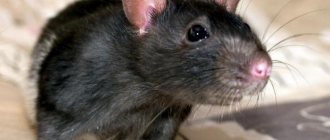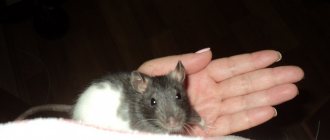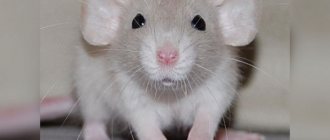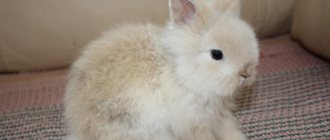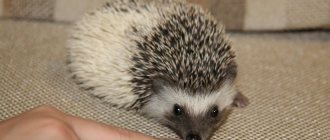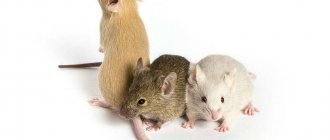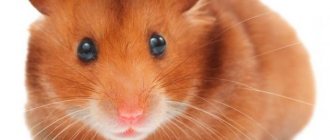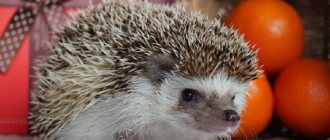Rat body language
Do you think only dogs can wag their tail? No – a rat’s tail can also tell a lot about the mood of its owner. The rat carefreely waves its tail from side to side - it means it’s glad to see you! Almost a dog, right? But the tail seems to twitch, or even freezes in one, sometimes unnatural, position - this is anxiety. Moreover, the rat is ready for defense!
Severe fear or stress is expressed in rats by the fact that the tail “walks” with a large amplitude. The animal is most likely very agitated and is clearly “out of its mind.”
Rats often use their front paws as a means of communication. They can wave their paws to attract attention. They may “bounce” with their forelimbs, indicating to be left alone. The treat will also be carefully grabbed by the front paws, and the expression on the face will tell you a lot!
The rat can sit down, slightly stooped or hunched, its muzzle is raised high, its paws are ready for “work”. This is a defensive pose, the rat is ready for aggression. There is no need to pester your pet at this moment. Let him burn out, calm down, and rest.
You can often notice that the animal’s fur seems to stand up and bristle. This indicates stress, fear, and also that your pet is simply cold. Move him to more comfortable conditions!
Treatment of pododermatitis in rabbits and rodents
Pododermatitis is a common disease of the skin, subcutaneous tissue and bones of the distal (lower) limbs of decorative rabbits and rodents. The causes of pododermatitis are discussed in a separate article, as well as in articles on feeding and keeping rabbits at home. The intensity and duration of treatment directly depend on the stage of the disease. But you should tune in for a period of 2–3 weeks to several months. In some cases, complete recovery cannot be achieved, and treatment is aimed only at stabilizing the condition. At the final stages of the process (when inflammation affects the bones, joints and ligaments of the limbs), treatment is not very effective. In such cases (for reasons of humanity), a decision must be made to euthanize the animal. Treatment involves:
1. Elimination of the causes of the disease: - correction of living conditions and nutrition; — excess weight control; - nail trimming; - physical exercise; - soft bedding.
2. Use of medications: - treatment of the affected area with ointments, sprays with antimicrobial, anti-inflammatory, wound-healing, drying effects;
- applying bandages with the above ointments; — a course of antibiotics (injections), from the list recommended for use in rabbits and herbivorous rodents; - use of painkillers (injections); — vitamin therapy (prescription of injections or oral medications); — surgical treatment (opening abscesses, cleaning wounds, cauterizing granulations, removing connective tissue growths); - sometimes - amputation of fingers or limbs. Treatment of pododermatitis always has a cautious prognosis. Quite often the prognosis is unfavorable.
In many cases, it is not possible to achieve a complete cure. This is due to the fact that it is impossible to completely remove the load (compression) from the site of the skin lesion. Because of this, the process of inflammation (in acute or chronic form) continues constantly. Other problems include difficulties with correcting excess body weight, as well as the presence of traumatic surfaces (linoleum, carpet, laminate, etc. instead of grass and soil). Since pododermatitis is a difficult to treat disease, the main thing that rabbit owners can do is to be familiar with the fact that such a problem exists in domestic rabbits in advance (at the time of purchasing a pet) and take preventive measures that boil down to proper feeding and maintenance.
Veterinarian Artem Arkadievich Kazakov
Veterinarian Tatyana Sergeevna Semirotova
Rats are very curious
Have you noticed an interested little face greedily sucking in air through its nose? This means that the animal is strongly attracted to something nearby, and it is trying to get as detailed information as possible. In this case, the rat can easily stand on its hind legs and stretch out to its full height in order to get a better look at the object that interests it! Your pet enthusiastically moves its head from side to side, while drawing in air - this means that it is too absorbed in something, and at the same time it uses all the “systems” of its body - vision, smell and hearing.
How to choose the right rat harness
Choosing a good rat harness is not an easy task. When making a choice, you must take into account certain factors and features. It is best to avoid collars. It will be very easy for a small pet to slip out of such a device. Even if you are able to purchase a quality collar that your pet cannot escape from, it can still pose a serious choking hazard. This is why you should always choose a harness that distributes pressure evenly across your entire chest.
It is also important to make sure that the harness you choose fits your pet comfortably. It should be loose enough to allow the rat to move freely, but tight enough to prevent the animal from escaping. Obviously, you won't find a harness specifically designed for rats. There's nothing to worry about here. Just look for those harnesses that fall into the small animal category.
Vocalization
We are accustomed to thinking that rats and mice are quite noisy animals. They tend to really actively communicate with each other using various sounds. Most of these sounds, however, cannot be distinguished by the human ear - they are in a higher frequency range. If you have a cat or dog, then you have probably noticed that from time to time they raise their heads and look intently towards the cage with rodents. Nothing surprising - it’s just that the cat or dog has become an unwitting listener to a conversation that is not “intended” for your ears.
The range of sounds that we do hear is quite narrow. As a rule, this is a very ordinary squeak, which means irritation, sometimes play or even a fight. You are much more likely to hear rat noises if you have two or more rats.
Physiological characteristics of the domestic rat
The average lifespan of furry rodents is about two years, but with proper care and maintenance, pet rats can live up to 4 years. Even a junior schoolchild can take care of rats on his own, for whom a smart rodent will definitely become his best friend.
In the wild, rats lead an active nocturnal lifestyle, sleeping during the day before the next hunt. At home, smart rodents often adapt to the lifestyle of their owners and begin to stay awake and play more during the daytime.
Teeth grinding
Rodent lovers also hear another specific sound, which experts call “bruxism.” Many people suffer from bruxism (“teeth grinding”) during sleep. With rats the situation is a little different; you can hear them grinding their teeth, as if they were grinding something very hard. A sort of creaking or grinding sound. Everything is natural - the usual behavior of all rodents. Some rats "gnash" quite intelligently; These sounds can only be clearly distinguished when in close proximity to the cell. By the way, bruxism is a good sign for rats: it means that she is now relaxed, and everything is fine in her life!
Grinding your teeth is actually very important for rats. Her front incisors are constantly growing and need to be ground down. Take a closer look at your little pet to see if the incisors are causing him any discomfort. Is everything okay with eating? If you see something suspicious, consult your veterinarian. In particularly advanced cases, surgery is sometimes indicated.
Original publication: How Rats Communicate, And How To Interpret It. Source and photo:
Arrangement of a cage for a decorative rat
The home of a domestic rat should be comfortable and cozy for the furry pet and contain the necessary accessories for feeding, smell absorption, play and rest of the animals. Must be purchased at the pet store at the same time as the cage.
Filler to absorb physiological odors
The most expensive, but most common option among rat breeders is corn litter. Wood fillers and sawdust are not recommended for use; these varieties can cause allergic reactions in pets. An inexpensive and popular filling option is white napkins or toilet paper, which require frequent cleaning. The use of newspapers and magazines for these purposes is prohibited. Rodents can be poisoned by printing ink.
Food bowls
For dry food, there are hanging bowls that are securely attached to the bars of the cage; it is advisable to give treats and liquid food in stable ceramic bowls.
Drinking bowl
It is necessary to hang a nipple drinker in the cage, which is convenient and safe to use.
House
Rodents love to rest and hide in their own house, at the bottom of which you can lay soft cloths. A plastic durable house can be installed at the bottom of the cage or suspended.
Hammock
A favorite place to relax and sleep is a soft hammock, which is suspended from the ceiling of the cage or between floors. It doesn’t matter to your pet whether this accessory is bought in a store or made independently from warm, cozy fabrics. It is necessary to periodically change and wash hammocks.
Toilet
Domestic rats are very clean; the animal independently chooses the corner in the cage where it goes to the toilet. You can equip this place with a special tray with filler or a container with high sides.
Climbing accessories and toys
If the size of the cage allows, you can hang ropes, ladders, tunnels, bridges, toys, and edible accessories.
Hyperkeratosis, dryness and flaking
Hyperkeratosis is a thickening of the stratum corneum. A layer of 1 to 10 mm is formed on the feet. The thickening is aggravated by the appearance of cracks, chronic formation of calluses and corns.
Excess weight, poor hygiene and the use of shoes made of synthetic materials are the main triggers of hyperkeratosis, among other reasons:
- genetic factor;
- age-related changes in the body;
- fungal infection;
- improper care of the skin of the feet;
- disturbances in the functioning of the endocrine system.
You can remove the effects of hyperkeratosis in a beauty salon. The pedicurist uses a combined technique, which includes the use of softeners and hardware treatment.
The maximum effect when removing rough skin is achieved when using cutters with an abrasiveness of 100-280 grit. The master gradually reduces the abrasiveness using different attachments.
Recommendations:
- using comfortable shoes;
- regular foot care with moisturizing creams;
- use of socks and shoes made from natural materials;
- regular visits to the podiatrist.
To combat dryness and flaking of the skin, urea-based products are used. The beauty parlors offer a procedure called cold paraffin therapy. A good effect is achieved by using wax applications and nourishing masks.
It is important not only to eliminate a cosmetic defect, but also to identify the causes of its occurrence and ensure proper prevention. If necessary, the podiatrist will give recommendations and refer you for consultations to specialized specialists to identify the cause of the defect.
Necessary materials
The simplest variety to make yourself is a figure eight shaped harness. In order to make it, you only need one rope. It should be long enough, so it should be used for the area around the neck and body. Therefore, its length should be at least 20cm. Any material will do. However, it is important to avoid rough abrasive ropes, which can irritate your rat's skin.
To create an H-shaped harness, you will need three nylon collars for small pets. You can buy adjustable collars for less than RUB 150 each. You will need three different sizes:
- A collar that fits the rat's neck.
- One that will hug her chest just behind her front paws.
- A long collar that will be used as a connecting element.
To create a vest harness you will need high-quality elastic fabric and a metal ring. You can use special fabric for animals, but regular fleece or cotton fabric will do just fine.
Factors
The success of settlement depends on many factors, such as:
Character of animals.
The calmer and more balanced the animals, the easier the placement will be. At the same time, you should not rely on assessing the character of an animal only on the basis of its communication with you - often animals, peaceful and affectionate with people, are quite aggressive towards their own kind. Therefore, only those who already have several rats living in the same group can evaluate their character and understand what to prepare for.
Age of animals.
The younger the rats being housed, the easier the placement. The best age for adoption is from about 6-7 weeks to 2.5 months. Later than this age, rats usually begin hormonal changes that last 5-8 months, which significantly increases the struggle for leadership in the pack and complicates the process of moving in, and a younger rat pup is still too weak to meet unfamiliar rats that may behave aggressively. It is worth considering that you should not share old rats (more than 2 years old) with old rats - the stress and hassles that are inevitable during sharing can cause irreparable harm to their health. It is better to place a couple of baby rats with older rats (1.8-2 years) and aged rats - they will be busy playing with each other and will not bother the adults too much.
Like/Hate.
Sometimes a move-in that is ideal in all aspects leads to failure or incredible difficulties only because the rats being moved in did not like each other “at first sight.” It's hard to say why one rat might not like another, but the fact remains. You can often see the opposite situation: a rat breeder, preparing for a long process fraught with problems, is surprised to discover that the rats clearly sympathize with each other, became friends from the first meeting and even moved in together themselves. But you shouldn’t hope for such an outcome; it’s still rare.
Experience in rat breeding and housing.
The more rats the owner kept, the more additions he carried out, the easier it would be for him to carry out another one. No recommendation, no rule can replace actions based on intuition. It is always very important to see and understand in time that something has gone wrong, or to relax and not disturb the rats if everything is in order.
Main varieties
There are 3 main types of harnesses. However, you can buy a collar, but it can put pressure on the rat’s neck. Therefore, you should choose from the following types of accessories:
- Figure 8 Harness - This type of harness has two loops, one going behind the front legs and the other going around the neck. The device is attached at the junction of two loops at the withers (the base of the neck above the shoulders).
- H-shaped harness – This accessory has two loops, like a figure eight. But the loops are not connected directly; they are connected by a separate piece of material, such as a nylon strap.
- A harness vest is a fitted fabric vest that fastens around the neck and belly with Velcro, buttons or zippers and has a ring at the back for attaching a leash.
If you don't want to buy a harness, you can make your own.
The process of creating a harness
To create a figure eight harness, follow these instructions:
- Fold the rope so that you have two unequal lengths: one about 15 cm and the other 2 cm.
- Wrap the center of the rope under the rat's neck.
- Cross the two sides of the rope behind the rat's back between its shoulders and pass the shorter part of the rope around the pet's chest just behind the paws and back up to meet the other side of the rope.
- Tie a knot where the two ropes intersect. This will allow you to adjust the harness when taking it on and off.
To make an H-shaped harness, repeat these steps:
- Remove the clasp from the long collar. Be sure to leave the leash ring intact so you have room to attach the harness.
- Measure the appropriate length of the connecting piece. Wrap the collars around the rat's neck and chest. Place the third collar along her back between her shoulder blades, with the leash ring in the middle, and mark the points where the third collar overlaps the far side of the other two collars.
- Sew loops on the ends of the connecting piece. Fold each end of the joining pieces just beyond the mark you made. Sew the folded ends together to form loops on each end.
- Thread the collar around your neck and chest through the loops to create an H-shaped harness. Once you pass the collars through the loops on the connector, your H-shaped harness is ready to use.
To create a harness vest, you will again need to measure the rat's neck, chest behind the legs and a few more centimeters on its torso. Then you can use stretch fabric.
- Cut the fabric to the desired size. You will need to leave some extra fabric for joining. If the vest is to be attached with Velcro or buttons, the two sides will need to completely overlap.
- Wrap the cut fabric around the rat and mark where its paws are.
- Cut out holes for the paws.
- Reinforce all edges of the fabric, including the paw holes, by folding the fabric and sewing it underneath.
- Attach Velcro, snaps, buttons or zippers.
- Sew a ring to the top of the vest between the rat's shoulders.
How to put a harness on a rat
When you are trying to put a rat harness on your pet, the most important factor to keep in mind is your pet's comfort level. It is important that the animal feels calm when wearing the harness. If your rat shows any signs of anxiety while you are trying to put the accessory on it, stop what you are doing immediately. You can try to give your pet some positive associations with the harness, such as offering him treats when he sniffs the harness or when you try to put it on.
Once you are able to put the harness on, let your pet get used to it without fastening it or tightening it. The rat will need to spend some time with the harness to get used to the sensation the accessory has on its neck and shoulders. If you notice signs of anxiety in your rat, remove the harness and offer it a treat. Try again after a while.
